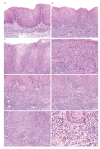Insights into incipient oral squamous cell carcinoma: a comprehensive south-american study
- PMID: 38794942
- PMCID: PMC11249374
- DOI: 10.4317/medoral.26551
Insights into incipient oral squamous cell carcinoma: a comprehensive south-american study
Abstract
Background: To describe demographic and clinicopathological aspects of a South-American cohort of incipient oral squamous cell carcinoma patients.
Material and methods: A cross-sectional, observational study was performed to assess demographic and clinicopathological characteristics of incipient oral squamous cell carcinoma patients from 6 South-American institutions.
Results: One hundred and seven patients within the histopathological spectrum of incipient oral squamous cell carcinoma (in-situ and microinvasive) were included. Fifty-eight (54.2%) patients were men with a mean age of 60.69 years. Forty-nine (45.8%) and thirty-nine (36.5%) patients had history of tobacco and alcohol use, respectively. Clinically, most of the lesions were plaques (82.2%), ≥ 2 cm in extension (72%), affecting the lateral border of the tongue (55.1%), and soft palate (12.1%) with a mixed (white and red) appearance. Eighty-two (76.7%) lesions were predominantly white and 25 (23.3%) predominantly red.
Conclusions: To the best of our knowledge, this is the largest cohort of incipient oral squamous cell carcinoma patients, which raises awareness of clinicians' inspection acuteness by demonstrating the most frequent clinical aspects of this disease, potentially improving oral cancer secondary prevention strategies.
Conflict of interest statement
The authors declare no conflict of interest, financial or otherwise.
Figures


References
-
- Bouvard V, Nethan ST, Singh D, Warnakulasuriya S, Mehrotra R, Chaturvedi AK. IARC Perspective on Oral Cancer Prevention. N Engl J Med. 2022;387:1999–2005. - PubMed
-
- Seoane J, Takkouche B, Varela-Centelles P, Tomás I, Seoane-Romero JM. Impact of delay in diagnosis on survival to head and neck carcinomas: a systematic review with meta-analysis. Clin Otolaryngol. 2012;37:99–106. - PubMed
-
- Almangush A, Bello IO, Coletta RD, Mäkitie AA, Mäkinen LK, Kauppila JH. For early-stage oral tongue cancer, depth of invasion and worst pattern of invasion are the strongest pathological predictors for locoregional recurrence and mortality. Virchows Arch. 2015;467:39–46. - PubMed
Publication types
MeSH terms
LinkOut - more resources
Full Text Sources
Medical

